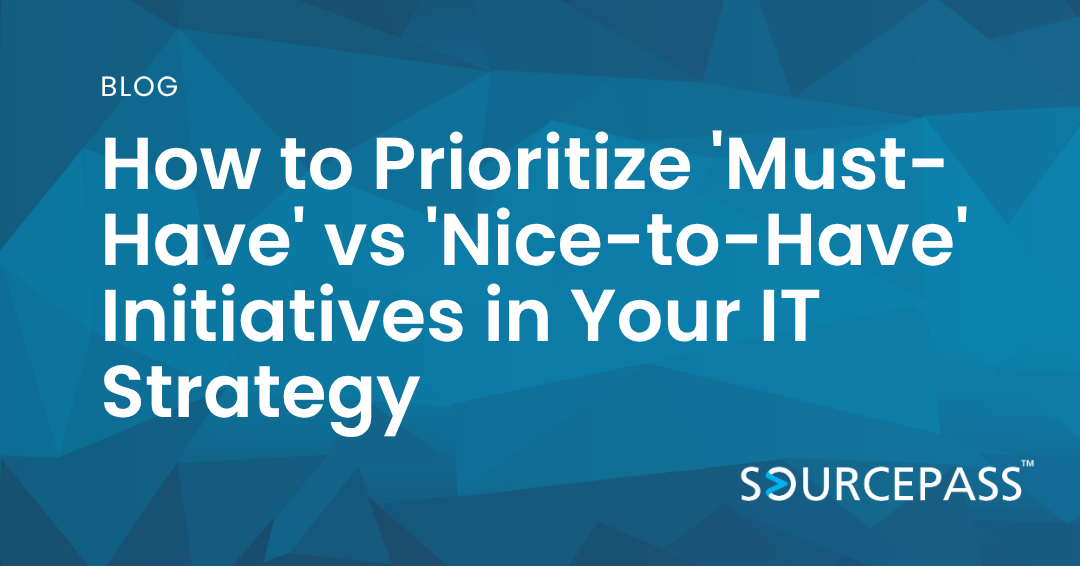How to Prioritize 'Must-Have' vs 'Nice-to-Have' Initiatives in Your IT Strategy
Jul 16, 2025 Alex Davis Strategy & Modernization 2 min read



When you start building an IT strategy or roadmap, it’s easy to dream big.
New systems, better cybersecurity, streamlined processes, cloud migrations — the possibilities are endless.
But resources aren't.
You’ll always face the challenge of choosing what to do now, what to plan for later, and what might not be worth the investment at all.
In short: you’ll need to prioritize.
And that often means making hard choices between must-have and nice-to-have initiatives.
Here’s a simple framework to help you do it confidently.
Step 1: Start with Business Impact
The first and most important filter: Does this initiative directly support a critical business goal?
Must-have initiatives usually fall into one of these categories:
- Protecting the business: (e.g., cybersecurity upgrades to prevent data breaches)
- Enabling growth: (e.g., infrastructure that supports new locations or services)
- Meeting compliance or legal requirements: (e.g., HIPAA, GDPR, CMMC standards)
- Fixing critical risks or gaps: (e.g., replacing end-of-life systems, addressing known vulnerabilities)
Nice-to-haves often promise improvements — but not solving an urgent problem or unlocking major growth.
Ask yourself:
If we didn’t do this in the next 12 months, would it significantly harm our business or hold us back?
If the answer is yes, it’s a must-have.
Step 2: Assess Risk and Urgency
Some initiatives become must-haves not because they drive immediate growth, but because they reduce serious risks.
Evaluate:
- Technical risk: Is the system or process vulnerable, outdated, or unsupported?
- Operational risk: Could downtime, outages, or inefficiencies impact operations or customer satisfaction?
- Financial risk: Could ignoring this issue cost you significant money in fines, breaches, or inefficiencies?
If an initiative addresses a high-risk area — even if it’s not “flashy” — it belongs near the top of your list.
Pro Tip: Use a simple High/Medium/Low risk scale to quickly categorize initiatives during planning sessions.
Step 3: Evaluate Resource Requirements
Even great ideas can become impractical if the timing isn’t right.
For each initiative, consider:
- Budget required (upfront and ongoing)
- Internal resources needed (IT team time, staff training)
- Disruption or downtime during implementation
- Dependency on other projects being completed first
You might find that some nice-to-haves make more sense once bigger foundational projects are completed.
This is especially important for smaller IT teams and growing businesses where resources are tight — focus your efforts where they will have the biggest, clearest impact first.
Step 4: Score and Rank Initiatives
Once you've evaluated business impact, risk, and resources, you can score initiatives to help rank them more objectively.
Example simple scoring system (1–5 scale):
- Business criticality (5 = mission critical, 1 = minor enhancement)
- Risk reduction (5 = high risk addressed, 1 = low risk)
- Cost/resource feasibility (5 = easy to do, 1 = extremely costly or disruptive)
Prioritize projects with the highest total scores — and look for clusters of must-haves you can tackle together for maximum efficiency.
Step 5: Communicate Prioritization Decisions Clearly
Prioritization is not just a technical exercise — it’s a business leadership responsibility.
Once you've made decisions, communicate the "why" behind them:
- What’s getting prioritized now
- What’s being deferred — and why
- How it ties back to protecting, growing, or enabling the business
Clear communication keeps leadership and stakeholders aligned — and avoids confusion, frustration, or second-guessing later.
Final Thoughts
In IT strategy, you can't do everything at once.
The most successful companies are the ones that:
- Ruthlessly prioritize what matters most
- Sequence initiatives smartly
- And stay flexible to adjust as the business evolves
At Sourcepass, we help growing businesses make these tough prioritization calls — building IT roadmaps that balance ambition with practicality, and vision with execution.
Subscribe To
Sourcepass Insights
Sourcepass Insights
Stay in the loop and never miss out on the latest updates by subscribing to our newsletter today!
.png?width=500&height=100&name=White%20Logo%20-%20Transparent%20Tag%20(3).png)



